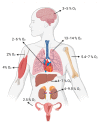Insight into Hypoxia Stemness Control
- PMID: 34440930
- PMCID: PMC8394199
- DOI: 10.3390/cells10082161
Insight into Hypoxia Stemness Control
Abstract
Recently, the research on stemness and multilineage differentiation mechanisms has greatly increased its value due to the potential therapeutic impact of stem cell-based approaches. Stem cells modulate their self-renewing and differentiation capacities in response to endogenous and/or extrinsic factors that can control stem cell fate. One key factor controlling stem cell phenotype is oxygen (O2). Several pieces of evidence demonstrated that the complexity of reproducing O2 physiological tensions and gradients in culture is responsible for defective stem cell behavior in vitro and after transplantation. This evidence is still worsened by considering that stem cells are conventionally incubated under non-physiological air O2 tension (21%). Therefore, the study of mechanisms and signaling activated at lower O2 tension, such as those existing under native microenvironments (referred to as hypoxia), represent an effective strategy to define if O2 is essential in preserving naïve stemness potential as well as in modulating their differentiation. Starting from this premise, the goal of the present review is to report the status of the art about the link existing between hypoxia and stemness providing insight into the factors/molecules involved, to design targeted strategies that, recapitulating naïve O2 signals, enable towards the therapeutic use of stem cell for tissue engineering and regenerative medicine.
Keywords: O2 tension; hypoxia; hypoxia in vitro models; hypoxia inducible factors; intracellular signaling; metabolism; stemness.
Conflict of interest statement
The authors declare no conflict of interest.
Figures






References
Publication types
MeSH terms
Substances
Grants and funding
LinkOut - more resources
Full Text Sources
Medical

